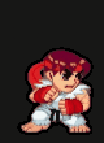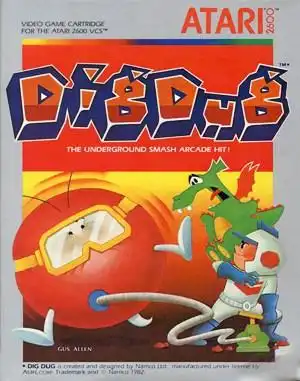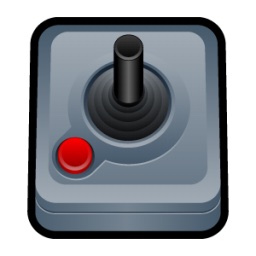Burrowing deep into the earth, armed with nothing but a shovel and an air pump – that was the simple, yet utterly addictive, premise of Dig Dug. While the arcade version was a coin-op king, for many, the true gateway to battling Pookas and Fygars was on a wood-paneled box hooked up to the family TV: the Dig Dug Atari 2600 port.
Released in 1983 by Atari themselves, this home conversion brought the frantic underground action to living rooms everywhere. It might not have looked exactly like the arcade cabinet, but it captured the spirit, the challenge, and the sheer fun that made the original a hit. Let's shovel some dirt and take a nostalgic look back at this 2600 classic.
The Simple, Satisfying Gameplay Loop
At its heart, Dig Dug is about survival and strategy in a confined, ever-changing environment. You control Dig Dug (or Taizo Hori, if you know your Namco lore!), whose goal is to clear each screen of subterranean monsters.
Your primary tools are:
- The Shovel: Digging tunnels through the dirt is how you navigate the levels, creating pathways and trapping enemies.
- The Pump: Your unique weapon! Hook an enemy with your air hose and pump them up until they pop. It's strangely satisfying.
- Rocks: Heavy boulders are scattered throughout the dirt. Digging beneath them makes them fall, crushing any unfortunate monster (or even yourself!) below. Using these strategically is key to high scores.
Enemies can only follow you through tunnels you've dug, but beware! They can also turn into ghostly forms and travel slowly through solid dirt to reach you. This forces you to keep moving and think about where you're digging.
Meeting the Neighbors: Pookas and Fygars
The underground isn't empty! You'll encounter two main types of baddies:
- Pookas: Round, orange creatures with goggles. They're the most common enemy and relatively straightforward to deal with.
- Fygars: Green dragons. More dangerous because they can breathe fire horizontally through tunnels! You need to be careful approaching them head-on.
As you progress through levels, the enemies get faster, smarter, and more numerous, cranking up the difficulty and the tension. Clearing a screen means popping every last one, though the final enemy will often try to escape off the top of the screen.
How Did the Atari 2600 Handle It?
Let's be honest, the Atari 2600 wasn't exactly a graphical powerhouse. Converting detailed arcade games was always a challenge. So, how did Dig Dug fare?
- Graphics: The sprites are simple but recognizable. Dig Dug himself, the Pookas, and Fygars are blocky but distinct. The rocks are just solid squares, lacking the cracks of the arcade version. However, the iconic ghostly enemy form is present and accounted for! The colors are vibrant, typical of the 2600's palette. It's a simplified version, but it gets the job done.
- Sound: This is where the 2600 port shines! The cheerful, looping "digging" music is instantly recognizable. The sound effects for pumping, popping, and rocks falling are spot-on. The eerie sound that plays when enemies are moving towards you through the dirt is particularly effective at building suspense. The audio captures the arcade feel surprisingly well.
- Gameplay Translation: Crucially, the core gameplay loop translated beautifully. The controls are responsive, digging feels natural, and the strategic elements of pumping, using rocks, and managing enemy movement are all intact. It feels like Dig Dug.
While graphically inferior to its arcade big brother, the Atari 2600 version of Dig Dug is widely considered one of the better ports on the system. It retained the addictive gameplay and memorable sound design that made the original a classic.
Why We Still Love It
For many who grew up with an Atari 2600, Dig Dug was a staple. It was easy to pick up but offered increasing challenge. The simple goal and satisfying actions (pop!) made it perfect for quick playthroughs or long, high-score chasing sessions.
It evokes memories of blowing dust out of cartridges, fiddling with the TV switchbox, and the pure joy of simple, effective game design. It's a testament to how compelling gameplay can transcend graphical limitations.
Finding the Game Today
Want to revisit the underground or experience it for the first time?
- Original Hardware: Hunt for a cartridge on eBay or at retro game stores. The original experience on a CRT TV has a certain charm.
- Emulation: Play it on a computer using an Atari 2600 emulator like Stella. You'll need the ROM file, which can sometimes be found on sites like Archive.org (check local copyright laws).
- Compilations: Dig Dug is often included in Namco or Atari retro game collections available on modern consoles and PC (like GOG or Steam), though these might feature the arcade version or later ports rather than the specific 2600 one.
Frequently Asked Questions
- Is the Atari 2600 version of Dig Dug exactly like the arcade? No, the graphics are significantly simplified on the 2600 hardware compared to the arcade original. However, the core gameplay mechanics and sound design are very faithfully recreated.
- Are there different versions of Dig Dug on Atari systems? Yes, Dig Dug was also released on the Atari 5200 and Atari 7800, which offered closer graphical representations to the arcade game.
- Who developed Dig Dug for the Atari 2600? Atari, Inc. developed and published the Atari 2600 port themselves.
Dig Dug on the Atari 2600 is more than just a port; it's a piece of gaming history for a generation. It proved that the spirit of a great game could survive the transition to less powerful hardware, delivering countless hours of underground fun. So grab your imaginary shovel and pump – there are still Pookas and Fygars waiting to be popped!


